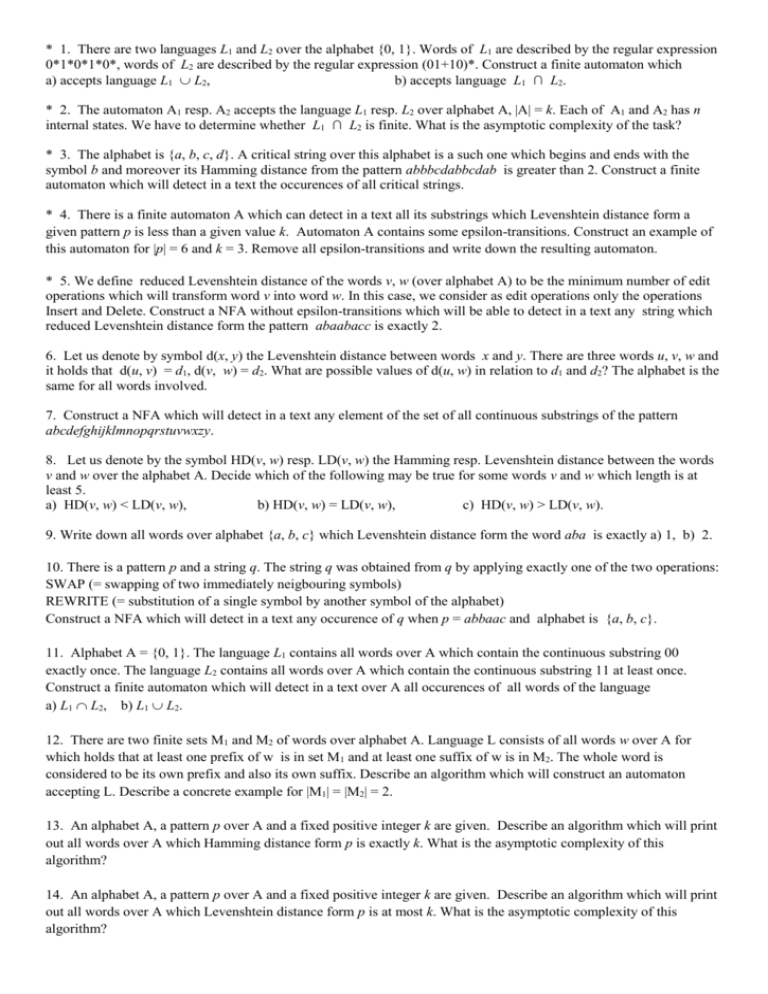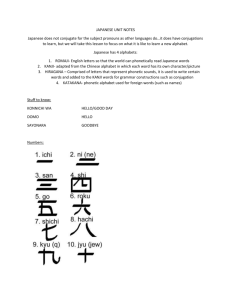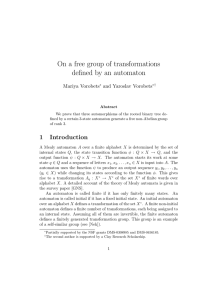1. There are two languages L1 and L2 over the alphabet {0, 1
advertisement

* 1. There are two languages L1 and L2 over the alphabet {0, 1}. Words of L1 are described by the regular expression
0*1*0*1*0*, words of L2 are described by the regular expression (01+10)*. Construct a finite automaton which
a) accepts language L1 L2,
b) accepts language L1 ∩ L2.
* 2. The automaton A1 resp. A2 accepts the language L1 resp. L2 over alphabet A, |A| = k. Each of A1 and A2 has n
internal states. We have to determine whether L1 ∩ L2 is finite. What is the asymptotic complexity of the task?
* 3. The alphabet is {a, b, c, d}. A critical string over this alphabet is a such one which begins and ends with the
symbol b and moreover its Hamming distance from the pattern abbbcdabbcdab is greater than 2. Construct a finite
automaton which will detect in a text the occurences of all critical strings.
* 4. There is a finite automaton A which can detect in a text all its substrings which Levenshtein distance form a
given pattern p is less than a given value k. Automaton A contains some epsilon-transitions. Construct an example of
this automaton for |p| = 6 and k = 3. Remove all epsilon-transitions and write down the resulting automaton.
* 5. We define reduced Levenshtein distance of the words v, w (over alphabet A) to be the minimum number of edit
operations which will transform word v into word w. In this case, we consider as edit operations only the operations
Insert and Delete. Construct a NFA without epsilon-transitions which will be able to detect in a text any string which
reduced Levenshtein distance form the pattern abaabacc is exactly 2.
6. Let us denote by symbol d(x, y) the Levenshtein distance between words x and y. There are three words u, v, w and
it holds that d(u, v) = d1, d(v, w) = d2. What are possible values of d(u, w) in relation to d1 and d2? The alphabet is the
same for all words involved.
7. Construct a NFA which will detect in a text any element of the set of all continuous substrings of the pattern
abcdefghijklmnopqrstuvwxzy.
8. Let us denote by the symbol HD(v, w) resp. LD(v, w) the Hamming resp. Levenshtein distance between the words
v and w over the alphabet A. Decide which of the following may be true for some words v and w which length is at
least 5.
a) HD(v, w) < LD(v, w),
b) HD(v, w) = LD(v, w),
c) HD(v, w) > LD(v, w).
9. Write down all words over alphabet {a, b, c} which Levenshtein distance form the word aba is exactly a) 1, b) 2.
10. There is a pattern p and a string q. The string q was obtained from q by applying exactly one of the two operations:
SWAP (= swapping of two immediately neigbouring symbols)
REWRITE (= substitution of a single symbol by another symbol of the alphabet)
Construct a NFA which will detect in a text any occurence of q when p = abbaac and alphabet is {a, b, c}.
11. Alphabet A = {0, 1}. The language L1 contains all words over A which contain the continuous substring 00
exactly once. The language L2 contains all words over A which contain the continuous substring 11 at least once.
Construct a finite automaton which will detect in a text over A all occurences of all words of the language
a) L1 L2, b) L1 L2.
12. There are two finite sets M1 and M2 of words over alphabet A. Language L consists of all words w over A for
which holds that at least one prefix of w is in set M1 and at least one suffix of w is in M2. The whole word is
considered to be its own prefix and also its own suffix. Describe an algorithm which will construct an automaton
accepting L. Describe a concrete example for |M1| = |M2| = 2.
13. An alphabet A, a pattern p over A and a fixed positive integer k are given. Describe an algorithm which will print
out all words over A which Hamming distance form p is exactly k. What is the asymptotic complexity of this
algorithm?
14. An alphabet A, a pattern p over A and a fixed positive integer k are given. Describe an algorithm which will print
out all words over A which Levenshtein distance form p is at most k. What is the asymptotic complexity of this
algorithm?









